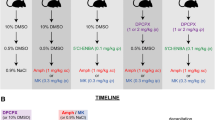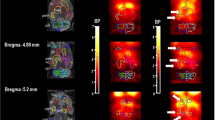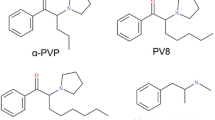Abstract
The effect of the D2-antagonist raclopride was investigated in two test situations, which are presumed to involve dopamine (DA) transmission within the nucleus accumbens of the rat. Local injection of d-amphetamine sulphate (10 μg/0.5 μl) produced a marked increase in motor activity, measured as motility, locomotion, and rearing, which was dose- and time-dependently antagonised by local injection of raclopride (0.05–5.0 μg/0.5 μl). After an initial decrease, at low doses (0.05–0.25 μg/0.5 μl) an apparent enhancement of the d-amphetamine-induced motor activity appeared, which was most clearly seen with rearing. These lower doses, however, did not induce any clear changes in the exploratory activity in a novel environment (i.e., the second test situation). Only the higher doses used (1.0–5.0 μg/0.5 μl) decreased exploratory activity during the first 5–10 min, also measured as motility, locomotion, and rearing. These data are discussed with respect to the role of D2-receptors within the nucleus accumbens of rats in the motor activity induced by a novel environment and d-amphetamine. Overall, the data underline previous notions that raclopride is a potent antagonist of DA-mediated behaviour.
Similar content being viewed by others
References
Cools AR, Peeters BWMM (1987) Behavioral function of neostriatal glutamate and its interaction with dopamine. Neurosci Res Commun 1:47–55
Costall B, Fortune DH, Hui SG, Naylor RJ (1980) Neuroleptic antagonism of the motor inhibitory effects of apomorphine within the nucleus accumbens: drug interaction at presynaptic receptors. Eur J Pharmacol 63:347–358
Ellenbroek B, Schwarz M, Sontag K-H, Japers R, Cools AR (1985) Muscular rigidity and delineation of a dopamine-specific neostriatal subregion: tonic EMG-activity in rats. Brain Res 345:132–140
Farde L, Hall H, Ehrin E, Sedvall G (1986) Quantitative analysis of D2 dopamine receptor binding in the living human brain by PET. Science 231:258–261
Farde L, Ehrin E, Eriksson L, Greitz T, Hall H, Hedström C-G, Litton JE, Sedvall G (1985) Substituted benzamides as ligands for visualization of dopamine receptor binding in the human brain by positron emission tomography. Proc Natl Acad Sci USA 82:3863–3867
Ferguson GA (1981) Statistical analysis in psychology and education, 5th edn. McGraw-Hill
Fifková E, Marsala J (1967) Stereotaxic atlasses for the cat, rabbit and rat. In: Bures J, Petran M, Zacher J (eds) Electrophysiological methods in biological research. Academic Press, New York, pp 653–696
Hall H, Sällemark M, Jerning E (1986) Effects of remoxipride and some related new substituted salicylamides on rat brain receptors. Acta Pharmacol Toxicol 58:61–70
Hillegaart V, Ahlenius S (1987) Effect of raclopride on exploratory locomotor activity, treadmill locomotion, conditioned avoidance behaviour and catalepsy in rats: behavioural profile comparisons between raclopride, haloperidol and preclamol. Pharmacol Toxicol 60:350–354
Kelly PH, Seviour PW, Iversen SD (1975) Amphetamine and apomorphine responses in the rat following 6-OHDA lesions of the nucleus accumbens septi and corpus striatum. Brain Res 94:507–522
Köhler C, Radesäter A-C (1986) Autoradiographic visualization of dopamine D-2 receptors in the monkey brain using the selective benzamide drug (3H)-raclopride. Neurosci Lett 66:85–90
Köhler C, Hall H, Ögren S-O, Gawell L (1985) Specific in vitro and in vivo binding of (3H)-raclopride; a potent substituted benzamide drug with high affinity for dopamine D-2 receptors in the rat brain. Biochem Pharmacol 34:2251–2259
König FRJ, Klippel RA (1963) The rat brain. Williamson and Wilkinson, Baltimore
Magnusson O, Fowler CJ, Köhler C, Ögren S-O (1986) Dopamine D2 receptors and dopamine metabolism. Neuropharmacology 25:187–197
Matthysse S (1981) Nucleus accumbens and schizophrenia, 1980. In: Chronister RB, De France JF (eds) The neurobiology of the nucleus accumbens. Haer Institute for Electrophysiological Research, pp 351–359
Morgenstern R, Fink H (1985) Sulpiride blocks postsynaptic dopamine receptors in the nucleus accumbens. J Neural Transm 61:151–160
Morgenstern R, Gold R, Oelssner W (1983) Lokomotorische Aktivität und Nucleus Accumbens. Biomed Biochim Acta 42:947–953
Ögren S-O, Köhler C, Fuxe K, Ängeby K (1979) Behavioral effects of ergot drugs. In: Fuxe K, Calne DB (eds) Dopaminergic ergot derivatives and motor function. Pergamon Press, New York, pp 187–205
Ögren S-O, Hall H, Köhler C, Magnusson O, Lindbom L-O, Ängeby K, Florvall L (1983) Remoxipride, a new potential antipsychotic compound with selective anti-dopaminergic actions in the rat brain. Eur J Pharmacol 102:459–474
Ögren S-O, Hall H, Köhler C, Magnusson O, Sjöstrand S-E (1986) The selective dopamine D2-receptor antagonist raclopride discriminates between dopamine mediated motor functions. Psychopharmacology 90:287–294
Paulis de T, Kumar Y, Johansson L, Rämsby S, Hall H, Sällemark M, Ängeby-Möller K, Ögren S-O (1986) Potential neuroleptic agents 4:Chemistry, behavioral pharmacology, and inhibition of (3H)-spiperone binding of 3,5-disubstituted N-((1-ethyl-2-pyrrolidinyl)methyl)-6-methoxy-salicylamides. J Med Chem 29:61–69
Pijnenburg AJJ, Honig WMM, van Rossum JM (1975) Inhibition of d-amphetamine-induced locomotor activity by injection of haloperidol into the nucleus accumbens of the rat. Psychopharmacologia 41:87–95
Pijnenburg AJJ, Honig WMM, van der Heijden JAM, van Rossum JM (1976) Effects of chemical stimulation of the mesolimbic dopamine system upon locomotor activity. Eur J Pharmacol 35:45–58
van Ree JM, Wolterink G (1981) Injection of low doses of apomorphine into rats reduces locomotor activity. Eur J Pharmacol 72:107–111
Robbins TW (1977) A critique of the methods available for the measurement of spontaneous motor activity. In: Iversen LL, Iversen SD, Snyder SH (eds) Handbook of psychopharmacology vol 7. Plenum Press, New York, pp 37–81
Sharp T, Zetterström T, Ljungberg T, Ungerstedt U (1987) A direct comparison of amphetamine-induced behaviours and regional brain dopamine release in the rat using intracerebral dialysis. Brain Res 401:322–330
Siegel S (1956) Nonparametric statistics for the behavioural sciences. McGraw Hill, Tokyo
Staton DM, Solomon PR (1984) Microinjections of d-amphetamine into the nucleus accumbens and caudate-putamen differentially affect stereotypy and locomotion in the rat. Physiol Psychol 12:159–162
Author information
Authors and Affiliations
Rights and permissions
About this article
Cite this article
van den Boss, R., Cools, A.R. & Ögren, SO. Differential effects of the selective D2-antagonist raclopride in the nucleus accumbens of the rat on spontaneous and d-amphetamine-induced activity. Psychopharmacology 95, 447–451 (1988). https://doi.org/10.1007/BF00172953
Received:
Revised:
Issue Date:
DOI: https://doi.org/10.1007/BF00172953




